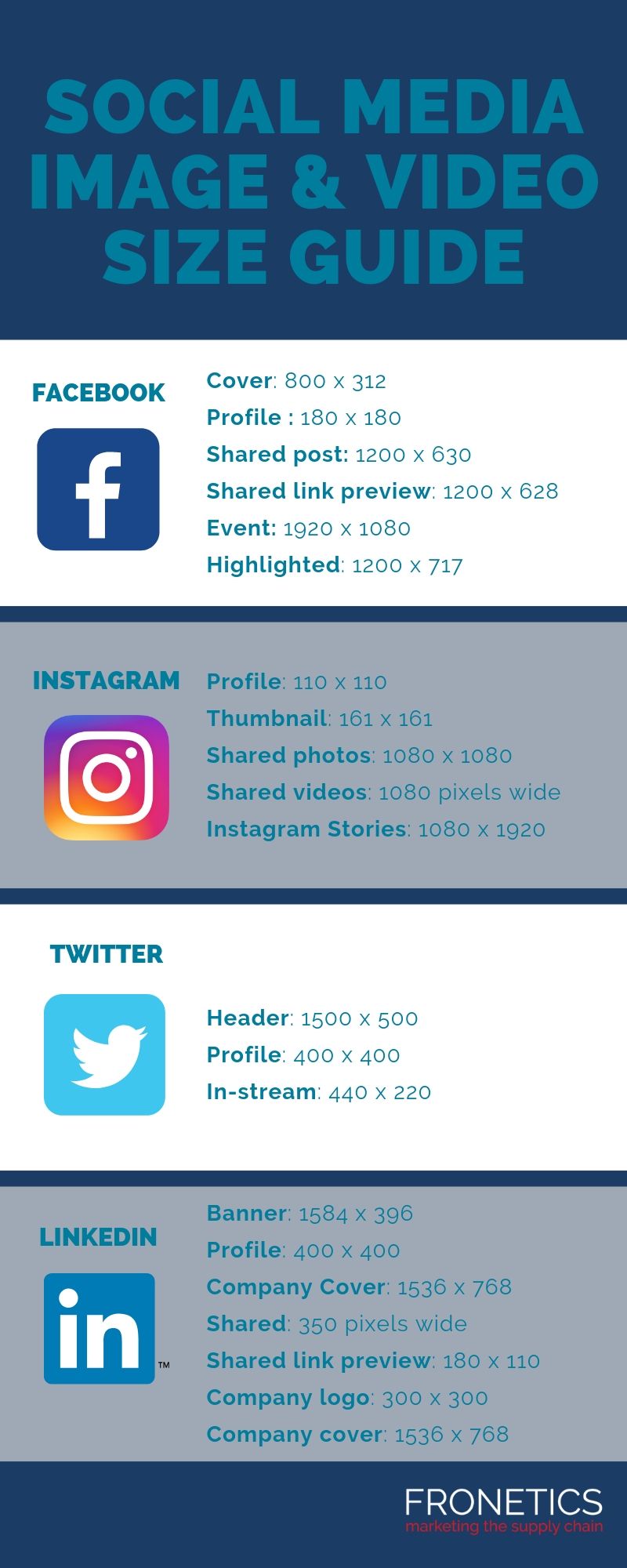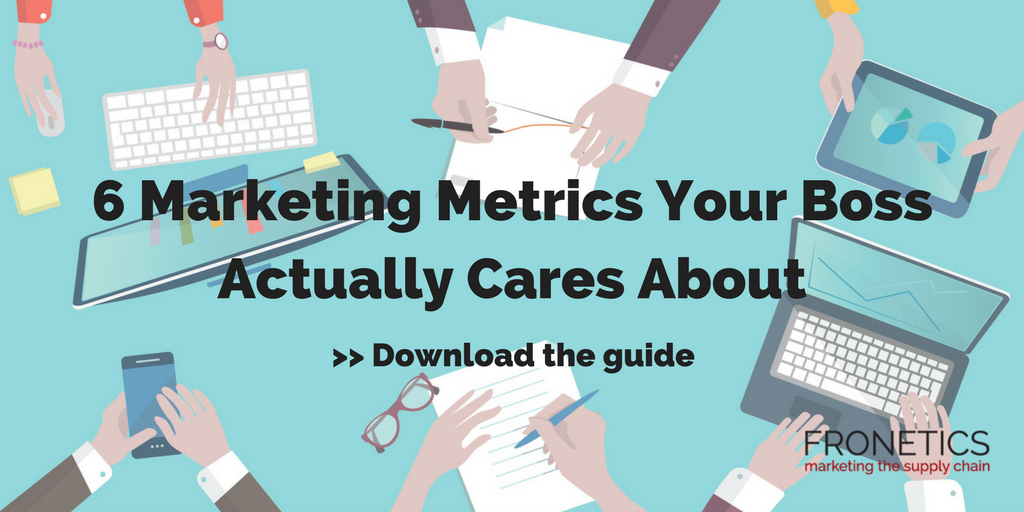
by Fronetics | Sep 26, 2019 | Blog, Current Events, Marketing, Social Media
Having the right social media image sizes for each platform is a key part of creating visually appealing posts.
Highlights:
- Each social media platform has its own set of image guidelines.
- Choosing the right social media image sizes ensures that your content is as visually appealing as possible.
- We like Canva Pro for quick resizing of images and graphics.
Social media is all about the visual. Whether it’s Instagram, Facebook, Twitter, or LinkedIn, having the right image can make or break the effectiveness of a post. Social media image size might seem like a relatively unimportant facet of choosing an effective image for a post. But you might be surprised to discover how important it can be.
An incorrect social media image size can make your post less visually appealing than it could be, and it can even erode how the number of impressions a post receives. Because each platform has its guidelines for sizes — and because each image type (profile picture, cover photo, etc.) has different size restrictions — determining correct social media image size is no easy task.
The infographic below gives you a complete guide to the various image size requirements on Facebook, Instagram, Twitter, and LinkedIn. Once you know the correct social media image sizes, you can set your photo editing software to the correct dimensions.
Social media image sizes: by the network

(Made with Canva)
Facebook
Facebook is perhaps the crown jewel of social media platforms, boasting 1.5 billion daily active users. While the platform is text-friendly, images are key to creating engaging content on the platform. An important thing to remember when it comes to images on Facebook is that they will display differently on your page’s timeline as compared to a user’s newsfeed. This means that your choice of image dimensions should be based on where you want your viewers to see your image.
Image dimensions:
- Cover image: 800 x 312
- Profile image: 180 x 180 (though it will display as 170 x 170 on desktop, and 32 x 32 as a thumbnail)
- Shared post image: 1200 x 630
- Shared link preview image: 1200 x 628
- Event image: 1920 x 1080
- Highlighted image: 1200 x 717
Instagram
Instagram is all about the visual – which means that it’s crucial that your brand’s presence on the platform is driven by high-quality images. As a rule, the platform scales down photos to 612 x 612, but it’s still recommended that shared images be set to 1080 x 1080 to optimize quality.
Image dimensions:
- Profile image: 110 x 110
- Image thumbnail: 161 x 161
- Shared photos: 1080 x 1080
- Shared videos: 1080 pixels wide
- Instagram Stories: 1080 x 1920 (minimum 600 x 1067); maximum 4 GB
Twitter
Twitter has 313 billion monthly active users and has recently updated its image guidelines.
Image dimensions:
- Header image: 1500 x 500; maximum 5 MB
- Profile image: 400 x 400; maximum 2 MB
- In-stream image: 440 x 220
LinkedIn
While the network may not be thought of as a highly visual platform, images on LinkedIn make a big difference in terms of post engagement. With 467 million registered users, it’s the world’s largest professional network. Having polished, well-sized images on the platform can go a long way toward maximizing its potential for professional networking and industry visibility.
Image dimensions:
- Banner image: 1584 x 396; maximum 4 MB
- Profile image: 400 x 400 (minimum 200 x 200); maximum 10 MB
- Company Cover image: 1536 x 768
- Shared image: 350 pixels wide
- Shared link preview: 180 x 110
- Company logo image: 300 x 300; maximum 4 MB
- Company cover image: 1536 x 768 (minimum 1192 x 220); maximum 4 MB
- Company page banner image: 646 x 220; maximum 2 MB
- Square logo (appears in company searches): 60 x 60; maximum 2 MB
An insider trick for quick and easy resizing
As you can see, there is quite a bit of variability in social media image sizes. You could spend hours resizing graphics or images for the same post across multiple platforms… Or, you could do what we do, and try a design platform like Canva. Not only does it already have all the proper dimensions available as templates, Canva Pro lets you change the size of graphics you created in a single click. It definitely makes life a lot easier.
Related posts:


by Jennifer Hart Yim | Sep 25, 2019 | Blog, Leadership, Strategy, Supply Chain, Talent
New research shows Gen X business leaders are being promoted slower than their millennial and boomer counterparts. This Gen X talent looking to jump ship.
This guest post comes to us from Argentus Supply Chain Recruiting, a boutique recruitment firm specializing in Supply Chain Management and Procurement.
Much attention has been given to millennial employees over the years –what attracts them, what causes them to stay in a role, how to manage them differently than other generations of employees. It was a hot topic of discussion at the recent SCMA National Conference. At the same time, more baby boomers are beginning to retire. These two generations represent the back and front end of the Supply Chain industry’s talent pipeline, and they’ve been the industry’s focus. But of course, the demographic picture is broader and more nuanced than just these two generations.
Last week, we wrote an article about the importance of the emerging Generation Z – people born between 1997 or so and the 2010s – to companies seeking to win the war for Supply Chain talent. Hopefully, it helped fill in the generational picture even further.
Now a recent, very interesting article in Harvard Business Review has us wondering – are Gen X employees being forgotten by the industry? If so, what’s the impact on their careers, as well as organizations who employ them – the companies who stand to lose if dissatisfied Gen X’ers begin to jump ship?
At the risk of explaining the obvious, Gen X’ers are generally defined as being born between the mid-1960s and early 1980s – after baby boomers, but before millennials. They also came of age with a reputation for being “unambitious” – a reputation that’s just as outdated as some of the most famous slacker movies (classic though those movies may be).
As we said with our article about Gen Z, these generational distinctions are a bit fraught. Career motivations are different for every person. They’re too complex to paint everyone with the same brush. But when you can marshal enough data, you can start to learn some interesting high-level things about the hopes, dreams, and discontents of a particular demographic. In 2018, HBR worked with EY and The Conference Board to collect and analyze data from some 25,000 business leaders. Those surveyed were from all over the business landscape, but there’s data here that will be useful for Supply Chain organizations looking in the mirror.
Some of the results related to Gen X in the workplace were very interesting, in particular:
- The majority of Gen X leaders (66%) had either not been promoted in the past 5 years, or had only been promoted once.
- Baby Boomer and Millennial leaders were more likely to receive promotions (58% and 52% respectively). This is unsurprising for the boomer generation, but it is surprising that a generation younger than Gen X seems to be getting promoted more. It suggests Gen X employees are being “skipped” compared to their counterparts.
- The data found that Gen X employees are promoted typically 20%-30% slower than millennials are.
- Generally speaking, Gen X managers have more direct reports than millennial managers at the same level, indicating a higher workload.
This is the situation on the ground for Gen X talent and leaders. But how are they responding to this lack of advancement?
Gen X employees tend to be more loyal to their current employers, with 37% contemplating leaving their current role compared to 42% for millennials. They came of age before the 2008 financial crisis, in a time before the rise of the gig economy, which might account for their willingness to spend longer in a role.
But companies shouldn’t mistake this loyalty for complacency: according to the data, only 58% of Gen X employees feel that their careers are advancing at a good rate, which is significantly lower than the 65% of millennials who feel the same way. Almost one in five Gen X leaders surveyed reported an increased desire to leave their current role (18%).
Many organizations are beginning to reckon with the retirement of the baby boomer generation. They’re trying to attract and retain millennial talent by improving opportunities for career growth. Maybe they should also be doing more to nurture Gen X talent, to avoid losing that all-important middle group within the talent landscape.
As Stephanie Neal, the HBR writer puts it, a significant number of Gen X’ers might be reaching a “breaking point in” their careers. But she identified some key strategies for companies to avoid neglecting Gen X talent:
- Invest not only in continuing education for employees, but personalize it. Most Gen X employees have developed a broad base of skills, but individual needs and desires vary. Organizations should tailor their talent development to each person. Stay interviews, which we’ve written about recently, are a good strategy to better understand what motivates each individual in your organization.
- Give Gen X leaders opportunity for mentorship, and not just within the organization. We also recently wrote about the power of mentorship in a Supply Chain career, so we were happy to see HBR highlight the importance of mentorship as well. According to the research, a majority of Gen X leaders craved mentorship outside their organizations, which is enabled by things like industry conferences and professional groups. Investment in these opportunities not only helps with retaining Gen X leaders, it also offers chances to expand your supplier network or find new business.
- Hire and promote based on data, rather than gut feelings. Hiring managers often work hard to try to eliminate unconscious bias from the hiring process, but ageism often goes under the radar. Applying stereotypes to a certain cohort introduces bias that harms your process and leads to dissatisfaction. Neal uses the example of assuming that a millennial would be better at a digital marketing role than a Gen X employee. Decisions based on data such as assessments and quantifiable achievements will always be more successful than those based on stereotypes.
It’s a good start, but maybe this is issue deserves an even closer look. If we may add another tip: avoid stereotypes. Data surveying the preferences and mindsets of a large group of people can be instructive, but don’t assume that every Gen X employee is wired the same way.
What do you think? Are there any specific talent retention strategies for individuals in the Gen X cohort? Are you of this generation, and if so, how do you feel about your career prospects? We’d love to hear from you.
Related posts:


by Fronetics | Sep 24, 2019 | Blog
Although content is extremely important, it’s only effective if it gets in front of the right audience. Here’s everything you need to know about content distrubution.
Highlights:
- Content distribution is the act of promoting content to online audiences in multiple media formats through various channels.
- Don’t fall victim to the “spray and pray” strategy where you post every piece of content anywhere and everywhere to increase the chances of achieving your desired results.
- Kick things off by looking at how each channel you want to use matches with the audience, your goals, and the priorities outlined in your overall content marketing plan.
Video transcript:
I’m Katie Russell, a marketing strategist here at Fronetics, and today we’re going to be talking about content distribution 101.
Content distribution is a term that’s often thrown around in marketing circles without any specifics attached. Given the growing popularity of content marketing, brands run the risk of having content lost in the shuffle. Here’s what you need to know to start implementing a successful content distribution strategy.
What is content distribution?
First off, what is content distribution? Content distribution is the act of promoting content to online audiences in multiple media formats through various channels.
There are three main components in the process for enabling your brand to build (and grow) communities of loyal, engaged consumers:
- Evaluate your distribution options
- Develop and document your strategy
- Promote your content
Evaluate your distribution options
Let’s start with evaluate your distribution options. Don’t fall victim to the “spray and pray” strategy where you post every piece of content anywhere and everywhere to increase the chances of achieving your desired results. You want to make sure your content is getting in front of the right people, with the right messaging.
Whether you are new at content marketing or a seasoned expert wanting to make the biggest splash possible, you need to decide which channels make the most sense for distribution. Some channels are more appropriate for your content than others, so you want a clear understanding of the unique value proposition of each, and how strongly those benefits align with your audience, brand voice, and goals.
Develop and document your strategy
Once you’ve generated a list of the most viable distribution options, building a strategy is the next step. Kick things off by looking at how each channel you want to use matches with the audience, your goals, and the priorities outlined in your overall content marketing plan. Resources and content types will help establish your editorial strategy. Make sure to document the details of your distribution decisions, so the information can be referenced easily, updated as necessary, and shared throughout your company.
Promote your content
Simply posting your content and waiting for your ideal audience to magically discover it won’t cut it. Make sure you are:
- optimizing your content with keywords, backlinks and calls to action
- repurposing and repackage top performing content
- consider sponsored content on social media sites
Want more information on how to successfully implement a content distribution strategy? Visit us at fronetics.com.
Related posts:


by Fronetics | Sep 19, 2019 | Blog, Data/Analytics, Marketing, Marketing Automation, Supply Chain
In a highly competitive B2B landscape, AI can be the strategic advantage your brand needs. Here’s everything you need to know about AI for marketing.
Highlights:
- AI enables predictive analysis – the ability to look at a large set of data and predict what steps to take to reach a desired outcome.
- Social listening powered by AI gives marketers key insights into brand perception and audience reaction.
- When considering purchasing an AI technology for marketing, consider if it includes its own Big Data source.
When we think about artificial intelligence (AI), it’s often with a twinge of unease. Whether it’s pop culture telling us that robots will take over at their earliest opportunity, or fears of human labor being replaced with machines, AI is a complex, controversial, and even mysterious topic. But when it comes to the applications of AI for marketing, there’s actually a lot to celebrate.
It’s important for marketers not only to have a thorough understanding of the uses of AI for marketing, but to be aware of industry trends, and how to determine investment to maximize ROI.
What is AI for marketing?
While it’s not necessary for marketers to be artificial intelligence and robotics experts, it’s beneficial to have a functional understanding of the technology that enables AI for marketing. In a general sense, the term “AI” refers to the area of computer science that enables the creation of software and machines that possess what we think of as intelligence. That is, they are able to work, react, and learn without being specifically programmed for each task.
AI is enabled by data science, “the practice of organizing and analyzing massive amounts of data.” When it comes to marketing, AI can be thought of as an extension and development of marketing automation. Essentially, AI for marketing is software that collects, analyzes, and reacts to large amounts of data, with increasing levels of sophistication.
According to content intelligence expert Bart Frischknecht, of Vennli, AI for marketing can be categorized in one of two ways.
- Recommending: This type of marketing software “predicts which action will have the most positive outcome in order to recommend a next step in a series of events.” Frischknecht describes these recommendations as “stepping stones on the way to fully automating a given task.”
- Automating: Software that automates is a furtherance of software that recommends. For a task to be automated, it needs to be “routine and repeatable, the goal needs to be specific, and the steps to achieve that goal must follow an exact set of rules.”
Think of data as the fuel that powers AI for marketing. As we gather more and more data, and devise increasingly sophisticated analytical methods, the possibilities for intelligent automation in marketing will continue to expand.
5 examples of AI for marketing
1) Data filtering and analysis
At Fronetics, we’ve advocated for a data-driven approach to marketing since our founding. For marketers, data is the most powerful strategic weapon in your arsenal, and AI is sharpening it even further. AI software can consolidate large amounts of data, and analyze it to determine patterns and trends.
2) Social listening
Social listening, also known as social monitoring, is the process of observing and examining social media, to identify and access what is being said about your brand. Social listening gives marketers valuable market intelligence, prospect insight, tone awareness, and competitive advantage.
Current AI software lets marketers not only engage in sophisticated social monitoring, but it also enables “sentiment analysis,” automatically generating a report of the overall attitude of your audience and perception of your brand.
3) Predictive analysis
Beyond simply filtering and analyzing data, AI for marketing goes a crucial step further: predictive analysis, the practice of applying the information extracted from data sets to predict a future outcome or trend.
This revolutionary capability of AI can be used to analyze buyer purchase behavior, for example, and determine when and how to distribute certain types of content. Social media scheduling tools, for instance, use predictive analysis to suggest the optimal times to share content.
4) Audience targeting and segmentation
As B2B buyers increasingly come to expect personalization at all stages of the buyer’s journey, it can be a challenge for marketers to deliver. However, AI makes personalization possible at a large scale, drawing on data to segment and categorize audiences.
The limits of the specificity of this segmentation are determined only by the amount of data available. In other words, the more data, the more the AI software can instantly segment a contact list and deliver personalized correspondence.
5) Chatbots
One of the most ubiquitous examples of AI for marketing, chatbots are computer programs that simulate human conversation using auditory or textual methods. Chatbots communicate with buyers within a messaging app, like Facebook messenger.
3 questions to ask when considering an investment in AI for marketing
While the possibilities of AI for marketing are virtually endless, the reality for most companies is that marketing budgets are not. When considering an investment in any technology, including AI, maximizing ROI should be top of mind. Frischknecht suggests that marketers ask the following three questions when considering an investment in AI for marketing:
- Which marketing task will this technology automate, and will doing so alleviate a significant burden for marketing staff?
- Does purchase of the tech include its own Big Data source, or do I need to provide all the data? If the latter, do I have adequate data, and can I connect my data source to the tech?
- What evidence exists of the tech making good recommendations or automating one of my tasks.
AI is revolutionizing marketing. Investing intelligently in these technologies can provide critical market insights, data processing capabilities, and predictive analysis.
Related posts:


by Fronetics | Sep 18, 2019 | Blog, Marketing, Social Media, Video Marketing
Here are 15 social video marketing statistics that every supply chain marketer should be aware of in 2019.
Highlights:
- 87% of business use video as a marketing tool.
- 83% of marketers report that video gives them a good ROI.
- Social video marketing trends to be on the lookout for: live video and 1:1 personalized video.
If you believe everything you read, you might think that social video marketing has taken a bit of a hit in the past year or so. Largely thanks to Facebook’s well-publicized inflation of video view metrics, companies are naturally wary of investing in video creation and promotion on the platform.
But Facebook’s transgressions shouldn’t undermine marketers’ confidence in the future of social video marketing. Both expert analysis and hard numbers support the notion that video isn’t going anywhere. As digital media expert Michael Humphrey puts it, “All the major upward trends still wrap around video.”
According to Lux Narayan, CEO of independent social analytics company Unmetric, audiences “are longing for more interactive experiences as well as long-form storytelling that only video can best achieve.”
Here are 15 social video marketing statistics we think supply chain marketers should be aware of.
15 social video marketing statistics for 2019
- 47% of internet users have watched brand advertising videos on social media within the past 3 months. (Toluna)
- Of the social media users who have watched branded videos in the past 3 months, 43% watched on Facebook, 38% on YouTube, 18% on Instagram, and 13% on Twitter. (Toluna)
- 87% of businesses now use video as a marketing tool, up from 63% in 2017. (Wyzowl)
- 55% of people consume videos thoroughly – the highest percentage of any content type. (HubSpot)
- 30% of users prefer video ads to text or still image ads, while 52% report having no preference. (Only 18% prefer text or still image ads). (Toluna)
- 83%of marketers say video gives them a good ROI, up from 78% in 2018. (Wyzowl)
- 52% of consumers say that watching product videos makes them more confident in online purchase decisions. (Invodo)
- 68%of people say they’d most prefer to learn about a new product or service by watching a short video, over text-based articles (15%), infographics (4%), presentations and pitches (4%), and ebooks and manuals (3%). (Wyzowl)
- 48% of social media users have sought more information about a product or service based on social video marketing. (Toluna)
- 33% of survey respondents answered yes to having bought a product or service from a brand solely based on social video marketing. (Toluna)
- 88% of video marketers are satisfied with the ROI of their video marketing efforts on social media. (Animoto)
- 82% of social media users prefer live video from a brand to social posts. (Impact)
- 81% of marketers say video has helped them generate leads, and 84% say video has helped them increase traffic to their website. (Wyzowl)
- 61% of marketers have made more marketing videos in house in 2018 than they did in 2017. (Animoto)
- 67% of users said they would like to see more social video marketing in the future over other types of ads. The remaining 33% are indifferent, not opposed. (Toluna)
The future of social video marketing
Suffice it to say, the numbers bear out the fact that video marketing, and particularly social video marketing, is a trend that’s here to stay. Live video is increasingly popular, and savvy brands are incorporating it into their strategies.
In addition to live video, given the growing ease of shooting video on smartphones, another big trend is likely to be 1:1 video. Marketers can nurture leads via personalized video messages, rather than phone calls or emails, using video to offer additional content, product support, or simply to foster a relationship.
The bottom line is that video offers up the kind of engaging storytelling that users today want. And social media is the ideal distribution platform for video, making social video marketing a winning strategy.
Related links:


by Fronetics | Sep 17, 2019 | Big Data, Blog, Data/Analytics, Internet of Things, Robotics & Automation, Supply Chain
Machine learning is shaping the future of supply chain and logistics management, improving accuracy, speed, scale, and more. Here’s how.
Highlights:
- Machine learning refers to an application of artificial intelligence that lets systems learn and improve automatically based on experience.
- Experts predict that 95% of supply chain planning vendors will rely on supervised and unsupervised machine learning for their solutions by 2020.
- When paired with the Internet of Things, machine learning can provide cost savings around $6 million per year.
When it comes to the future of the supply chain, machine learning is one of the most exciting applications of artificial intelligence (AI) technology out there today. Machine learning is a mode of data analysis that provides systems with the ability to learn and improve automatically from experience, without being specifically programmed.
Gartner recently projected that by 2020, 95% of supply chain planning vendors will rely on supervised and unsupervised machine learning for their solutions. Furthermore, it isn’t just expert predictions that demonstrate the impact and potential of machine learning for the supply chain. Amazon, for example, is using machine learning to improve accuracy, speed, and scale for its Kiva robotics, and DHL relies on machine learning to power its Predictive Network Management system.
So, what is it about machine learning that makes it ideally suited to meet the challenges commonly faced by supply chain companies? The answer lies in the fact that machine learning algorithms are brilliant at detecting patterns, anomalies, and predictive insights. This makes it the ideal technology to help supply chain companies forecast error rates, reduce costs, improve demand planning productivity, and increase on-time shipments.
Here’s how these remarkable technologies are already revolutionizing supply chain management.
7 ways machine learning is improving supply chain management
1) Logistic solutions
Particularly when it comes to resource scheduling systems, machine learning algorithms are driving the next generation of logistics technologies. An April 2019 report from McKinsey predicts that “machine learning’s most significant contributions will be in providing supply chain operators with more significant insights into how supply chain performance can be improved, anticipating anomalies in logistics costs and performance before they occur.”
2) Internet of Things
The Internet of Things (IoT)’s sensors, intelligent transport systems, and traffic data generate a tremendous variation in data sets. Machine learning has the potential to deliver increased value by analyzing these data sets, thereby optimizing logistics and ensuring that materials arrive timely.
Additionally, machine learning can reduce logistics costs by uncovering patterns in track-and-trace data captured through IoT-enabled sensors. A December 2018 study by Boston Consulting Group determined that pairing machine learning (specifically Blockchain) with the IoT can contribute to cost savings of $6 million per year.
3) Preventing privileged credential abuse
A recent article in Forbes points to privileged credential abuse as “the leading cause of security breaches across global supply chains.” Machine learning can prevent these abuses by verifying the identity of anyone requesting access, as well as the context of the request and, most importantly, the risk associated with the access environment.
4) Reducing fraud potential
In addition to reducing risk and improving product and process quality, machine learning can reduce the potential for fraud in the supply chain. For example, machine learning startup Inspectorio is a solution to the problems “that a lack of inspection and supply chain visibility creates, focusing on how they can solve them immediately for brands and retailers.” Their algorithm provides insights that instantaneously reduce the risk of fraud.
5) Reducing forecast errors
According to a recent report from Digital/McKinsey, “Lost sales due to products not being available are being reduced up to 65% through the use of machine learning-based planning and optimization techniques.” The same report observes that “inventory reductions of 20 to 50% are being achieved today when machine learning-based supply chain management systems are used.”
6) Detecting inconsistent supplier quality levels
Machine learning can help manufacturers combat one of the biggest problems they face today, namely a lack of consistent quality and delivery performance from suppliers. These technologies can quickly detect and address errors, as well as determine highest and lowest performing suppliers.
7) Preventative maintenance
Preventative maintenance is a tremendous strategic asset for the supply chain. And, when paired with machine learning, it “allows for better prediction and avoidance of machine failure by combining data from the advanced IoT sensors and maintenance logs as well as external sources,” according to the same Digital/McKinsey study mentioned above. Not only that, “asset productivity increases of up to 20% are possible, and overall maintenance costs may be reduced by up to 10%.”
The bottom line: machine learning is reinventing supply chain management
Not only has machine learning already realized tremendous value for the supply chain, but the very nature of this technology means that the possibilities are virtually endless. Algorithms continue to become more sophisticated, and, as new challenges arise, machine learning grows and evolves to meet them.
Related posts:












